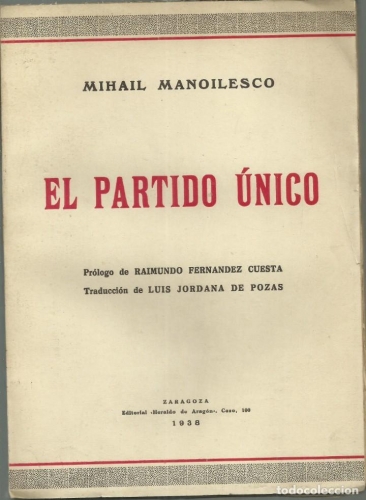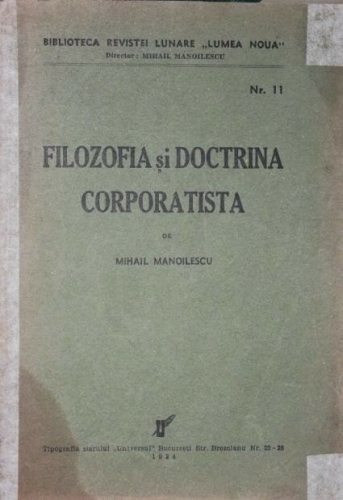Ex: http://www.themarketforideas.com
Mihail Manoilescu, more than an engineer, journalist or professor, was a Romanian political and economic thinker. Although in his country he was not recognized and his theory used, he has inspired other countries in different regions. His ascension was great, as great as his fall. Mihail Manoilescu ended up in the darkness of oblivion, obscurity and, consequently, death.
Early years
Mihail Manoilescu was born on December the 9th, 1891, in Tecuci, Romania, coming from a family with old boyar origins (Boyar was a nobility title attributed to members of the 10th-17th century Russian aristocracy). In 1893 the family moved to Iași. Mihail Manoilescu remained there until he began his university studies. His father, Constantin Manoilescu, was a teacher and member of the Socialist Party. Natalia Grigoreanu, his mother, was also a teacher.
In 1910, he graduated from the National High School in Iași. Mihail Manoilescu wanted to pursue law studies, but his precarious financial situation, left fatherless when he was nine years old, did not permit it. Consequently, he applied and was admitted to the National School of Bridges and Roads in Bucharest (now The University Politehnica of Bucharest), and graduated as valedictorian in 1915.
He was assigned to the Ministry of Internal Affairs after completing his university studies, as an engineer, in an artillery regiment in Roman, Moldova. Under Eng. Tancred Constatinescu’s leadership, he built an original model of howitzer (the “Manoilescu type” 210 mm howitzer). Mihail Manoilescu’s career started in the military area and, after the First World War, became the General Director of the Ministry of Industry and Trade in 1921.
Mihail Manoilescu started his incursion into the business world through investment in the minerals sector. Together with his brother, Grigore Manoilescu, he became co-owner of Sorecani Mines, in Cluj County. They made a significant investment and opened new galleries considerably increasing the production of lignite. They established an agreement with the Belgian company Electrobel to build a power plant in Aghireșu, inaugurated in 1930.
Economic thought
While developing his financial backing and power, including by becoming shareholder in a bank, Mihail Manoilescu published a book that many consider his greatest and most relevant bibliographical work: Théorie du protectionnisme et de l’échange international (Theory of protectionism and international exchange) in 1929.
Looking for a simple overview of the main ideas/concepts of Mihail Manoilescu, Sorin Șuteu (2016) considered the “author’s main findings:
- In any country, labour productivity varies considerably depending on the economic branch. The biggest differences are between industry and agriculture. Their report is relatively constant and was named the Manoilescu constant.
- It makes the industrialized countries have considerably higher labour productivity than predominantly agrarian countries.
- As a result, in international trade, when an industrialized country sells a product to an agrarian country, we actually talk about the exchange between the work of a small number of industrial workers and the work of a large number of agricultural workers”.
Manoilescu, as per above considerations, considered that industrialized countries had the capacity and power to exploit agricultural countries by means of trade. The natural consequences of this situation were the losses in the national income that were recorded. In order to solve these shortcomings, “the author proposes two solutions:
- The industrial way, consisting in the manufacture of goods, in the country, with labour productivity above the national average.
- The commercial way, based on the importation of those goods with lower labour productivity than the national average” (Șuteu 2016).
To implement these ideas, Mihail Manoilescu’s recommendation is to adopt the measures aimed to protect and stimulate the economic sectors with productivity above the national average.
Although influenced by the economist Friederich List, he theoretically distanced himself from List: the protection he advocated was not temporary. He believed he had identified an important exception to the conclusions derived from exchange models, based on the presumed perfect competitiveness of the markets, which were behind the free trade policy advocated by most economists.
 Impact abroad
Impact abroad
At the time it was published, the book was harshly criticized by classical economists such as Jacob Viner (1932), or neoclassicists such as Bertil Ohlin (1933). In 1954, future Nobel laureate Arthur Lewis seems to have independently presented the argument, originally proposed by Manoilescu, that protection was justified in less developed countries, where wages in industry were excessive in relation to agriculture (Lewis 1954, 159). In the late 1950s, Everett Hagen also concluded in an article that historical experience suggested that protectionism was responsible for the acceleration of economic progress in countless countries, which were fully industrialized after the English Industrial Revolution. The United States, Japan, the Soviet Union and three Latin American countries – Brazil, Colombia and Mexico – clearly exemplified this statement. In each of these cases, the increase in per capita income was associated with the greater participation of the industrial sector in the global income, that is, the income of industrial employees increased more than the growth of the world economy. Therefore, it was statistically true that industry contributed more to raising per capita income.
This theory was very well received in Latin America. At this time, Brazil was in a very serious economic crisis following the Great Depression of 1929. So, this theory was growing because of the difficulties and challenges that Brazil experienced in the export competition with African and Asian countries. This fact was used to justify the low wages in Brazil.
The industrialists of São Paulo generally supported the values of organization, elitism, industrialization and, increasingly, as the 1930s progressed, of state intervention in the economy. After 1937, they also supported the Getúlio Vargas (1937-45) dictatorship. It is no wonder, therefore, that they were attracted to Manoilescu’s theses, values, and attitudes.
Industrial production grew by 50% between 1929 and 1937, creating income and strengthening the domestic market (Furtado 1980). The Brazilian economy recovered relatively quickly after the crisis, returning to a 9% annual growth rate already in 1934. This policy generated deficits for the government, but sustained the level of economic activity; the domestic protection given to the industry through exchange control, the regulation of the compulsory consumption of domestic production of raw materials, and the prohibition of imports by idle companies were fundamental for the industry to grow at an average of 10% per year between 1930 and 1936. Rising imports stimulated the use of the idle capacity of industries; fiscal, monetary, credit, and coffee policies ensured demand on the other side, causing industry to grow by more than 11% a year between 1934 and 1937.
Impact at home
In Romania, the protectionist doctrine of Manoilescu could not be applied. This doctrine was not accepted in the geopolitical context of the nation. After 1944, another model of development was applied by external imposition. In Brazil and in other Latin American countries as well, political and intellectual elites evinced a pragmatism in thought and action that was free to adopt Manoilescu’s theory as the basis for economic development strategies.
 It is important to consider that, over time, Manoilescu not only acquired sympathy for Nazi and fascist regimes, but also he was a believer in these social and political models. The subsequent situation of Soviet dominance in Romania, mainly after the end of the Romanian-German alignment, made impossible any attempt or intention to adopt his economic conceptions.
It is important to consider that, over time, Manoilescu not only acquired sympathy for Nazi and fascist regimes, but also he was a believer in these social and political models. The subsequent situation of Soviet dominance in Romania, mainly after the end of the Romanian-German alignment, made impossible any attempt or intention to adopt his economic conceptions.
After World War II, Manoilescu completely lost his credibility, mainly because of the support he gave to the regimes that were in place, or that would come to take power in the 1930s, in Italy, Germany, Spain, Portugal and Brazil, then for the eventual failures of his theory. His political pragmatism led him to renege on his economic ideas, to support the Third Reich on the eve of the war, and to advocate Romania’s insertion into the German war effort as a supplier of primary products.
Through his influence and integration into Romanian political power before the fall of the Nazi regime, his status, credibility and his own life would be doomed. In 1945, Mihail Manoilescu was arrested for one year and two months, without a trial. He was also fired from the Political Economy Department of the University Politehnica of Bucharest and purged from university surroundings. He was released from the prison, but kept under surveillance.
In 1948, Mihail Manoilescu was arrested again for political reasons. He was taken to several prisons and, in 1950, he was jailed in Sighet together with the former officials of the interwar and war periods, who had been incarcerated in conditions of extermination and who had never been brought to trial. He died in prison on December 30th, 1950. The family was only notified eight years after, in May 1958. After his death, legal procedures were brought against him for his activity as a journalist and he was sentenced in absentia on April 1952.
Conclusion
It is verified that the bibliographical work and the protectionist theory of Manoilescu gained great importance for the foreign countries, mainly in the case of Brazil. Over time, his economic theses were re-evaluated and not all of them were discarded, being analysed until the present day, contributing to the enrichment of the debates about the adoption of national economic measures.
Photo credit: https://expo1921.mnir.ro/ro/expozitia/expozitia-si-targul...
Bibliography
Furtado, C. 1980. Formação Econômica do Brasil. São Paulo: Ed. Nacional, http://www.afoiceeomartelo.com.br/posfsa/Autores/Furtado,....
Lewis, W.A. 1954. Economic Development with Unlimited Supplies of Labour. The Manchester School 22(2): 139-191.
Love, J.L. 1996. Crafting the Third World: Theorizing Underdevelopment in Rumania and Brazil. Stanford University Press, https://books.google.ro/.
Pușcaș, V.; Sălăgean, M. 2012. Mihail Manoilescu – Economic Thought and Economic Reality. Anuarul Institutului de Istorie “George Barițiu” din Cluj-Napoca, tom LI: 325-336, http://www.historica-cluj.ro/anuare/AnuarHistorica2012/19....
Silva, L.O. 2010. Roberto Simonsen: A industrialização brasileira e a Segunda Guerra Mundial. História Econômica & História de Empresas 13(2): 25-52, https://doi.org/10.29182/hehe.v13i2.
Șuteu, S. 2016. Mihail Manoilescu and the Theory of Protectionism. Revista de Management și Inginerie Economică 15(4) http://www.rmee.org/abstracturi/62/20_Personalitati_Mihai....






 del.icio.us
del.icio.us
 Digg
Digg